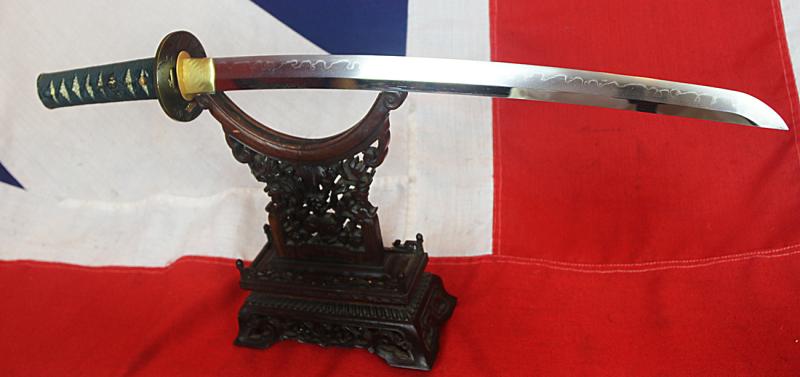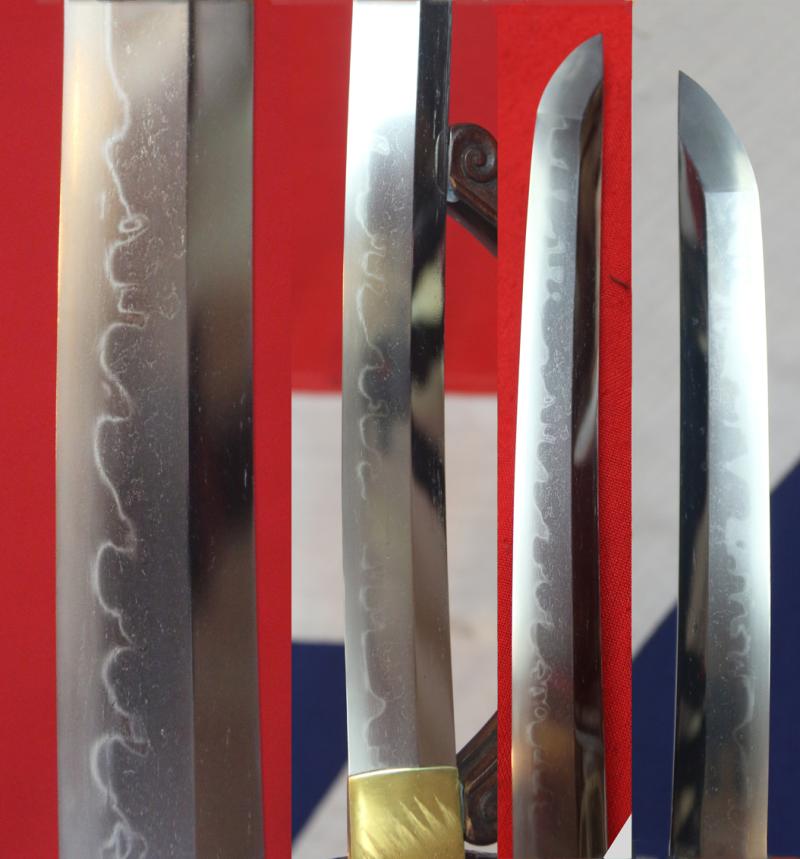SOLD A Spectacular Museum Quality Wakizachi Art Sword Sue Seki School Of Seki City in Mino Province, Central Japan, Of The 1500's. All Original, Very Fine Edo Fittings, Of Pure Gold Decorated Shakudo & NBTHK Papers
This sword has a Hozon certificate issued by NBTHK. This authentication paper was only given to Japanese swords, worth preserving by Nihon Bijutsu Touken Hozon Kyokai(the Society for the Preservation of the Japan Art Sword).
Sueseki refers to the sword makers who forged swords from Mino province at the end of the Muromachi Period.The Mino swordsmiths style, also known as Mino-Den, basically has the Togari (Pointed shapes protruding from the Hamon ) in a classic straight line and random temper line with some white Utsuri. Mino-Den had its origin from Yamato-Den in the late Kamakura period(1280-1330). It flourished in the Muromachi period(1333-1573) and continued until the Edo period(1603-1868).
Mino-Den especially prospered during Sengoku Jidai (Warring State period) due to the high demand for weapons. And the location of Mino province beat others. Akechi Mitsuhide controlled Mino province, and Nobunaga Oda ruled Owari province, and Tokugawa Ieyasu was the lord of Suruga (Neighboring areas). There was high demand from those powerful feudal lords and their retainers.
Furthermore, so many wars occurred between the Kanto region and the Kyoto area, and Mino is located in the middle, making feudal lords feel convenient to order swords from Mino-Den. The blades forged in Mino provinces {now called Gifu Prefecture} also had the reputation of its practical design and sharpness. Many feudal lords demanded swords forged in the Mino province.
Koto blade circa 1550, superb midare hamon, and iconic itame hada, fully bound tsuka with shakudo fuchi-kashira decorated with prunus blossom in gold, shakudo and gold and shakudo menuki, circular shakudo tsuba decorated with prunus and pine branches, gold details on a nanako ground, contained in its black ishime lacquered saya stunningly decorated with scrolling waves, with a fine shakudo nanako kodzuka decorated with pine cones in two colour gold.
Nanako Ji: "fish roe ground" A surface decoration produced by forming very small raised bosses by a sharply struck punch or burin called 'nanako tagane'. Shakudo is the metal most often used, but copper and gold are quite often employed. The harder metals, shibuichi, silver and iron are rarely decorated in this way. The size of the dots vary from 0.04" to 0.008" (25 to 125 and inch) and the regularity of the work is marvellous as the dots must be spaced entirely by touch. The dots are usually arranged in straight lines or in lines parallel to the edge of the piece being decorated, but sometimes in more elaborate patterns. Used on guards since the Momoyama period although the technique existed since much earlier periods. Usually done by specialist 'nanako-shi', but sometimes done by the maker of the guard himself.
Shakudo is a billon of gold and copper (typically 4-10% gold, 96-90% copper) which can be treated to form an indigo/black patina resembling lacquer. Unpatinated shakudo Visually resembles bronze; the dark color is induced by applying and heating rokusho, a special patination formula.
Shakudo Was historically used in Japan to construct or decorate katana fittings such as tsuba, menuki, and kozuka; as well as other small ornaments. When it was introduced to the West in the mid-19th century, it was thought to be previously unknown outside Asia, but recent studies have suggested close similarities to certain decorative alloys used in ancient Egypt, Greece, and Rome.
The above descriptions show just why the finest Japanese fully mounted swords can be referred to as ‘Art Swords’, not because they were made just to be items of incredible beauty, to admire and revere, but also as useable everyday swords to be worn by highest status samurai and clan lords, that are also statements of the status of the wearer, as well as of the finest beauty and artistic merit
99% of our swords left Japan in the 1870's so none have the traditional 'papers' issued post WW2. And have never returned to Japan for papering. However, as with this sword, we acquire swords from serious collectors who have either sent swords to Japan for papering, or, had a sword papered before it arrived in the UK, such as this sword, that was papered almost 20 years ago.
The blade has its 28th June 2007 Hozon papers of the NBTHK
This sword is no longer available
Code: 25345










